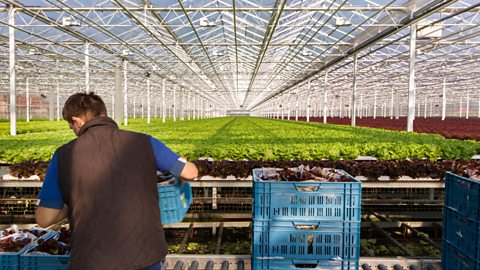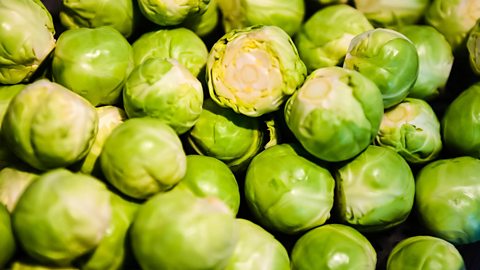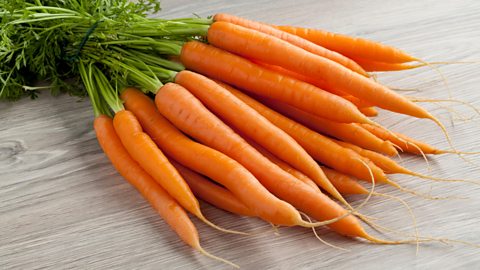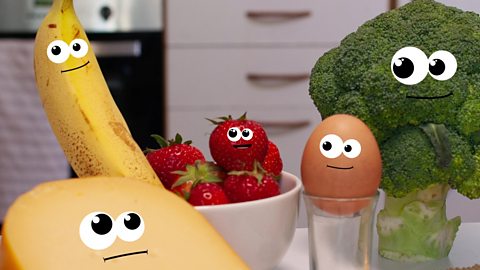What does seasonal food mean?
Different foods grow better at different times of the year. This is called seasonality.
In this article you can learn:
- what seasonal eating is
- which food items are seasonal at each time of year
- advantages of seasonal food
- how technology has changed the way we eat
- the environmental impact of the food we eat
This resource is suitable for Health and Wellbeing for primary school learners.
Video - Seasonal food
In this video, the Great Spoon explains what seasonal eating means and the advantages of eating seasonal food.
Find out about seasonal food and its advantages.
LIGHTNING STRIKES
PEPPER HUMS
PEPPER Oooh, I'm bored… It’s a bit dark and dreary round here at this time of year.
SALT I know! It was much more exciting in summer. So many different foods. So colourful.
PEPPER And now it’s all a bit dull.
ONION That’s insulting!
EGG Who are you calling dull?
SALT You’re not exactly colourful
PEPPER Where have all the exciting foods gone?
THE GREAT SPOON °їіу… CLEARS THROAT Different foods are farmed, and taken to the shops at different times throughout the year. The term for this is seasonal.
EGG Seasoning?
THE GREAT SPOON What? No! Seasonal! Mushrooms naturally prefer the autumn when it’s cool and damp outside.
MUSHROOM Scotland is a dream!
THE GREAT SPOON Some mushrooms are farmed indoors under perfectly controlled conditions. They are available all year round.
EGG Not everything is seasonal though! Don’t forget us eggs. We come from an animal, so it doesn’t matter what time of year it is. Eggs, meat and dairy are farmed January through to December.
PEPPER Hang on? That fruit over there is a bit more colourful. Oi! You! Pineapple! What’s your deal? Do you come from an animal?
PINEAPPLE Absolutely not! I’ve never been near an animal! And it’s far too cold and dark up here in Scotland for my liking!
THE GREAT SPOON Pineapples need very hot weather to grow so they come from places abroad where it’s warmer and sunnier.
PINEAPPLE There’s so much sizzling sunshine where I grew up. I’m a Costa Rican pineapple!
PARSNIP Oh lovely! How tropical! I’ve always wanted to go to Costa Rica!
PINEAPPLE I don’t think the hot weather would suit you.
THE GREAT SPOON And although pineapple is around all year, it still has seasons and is at its sweetest between March and July.
PINEAPPLE I would say I am sweet all year round, honey!
THE GREAT SPOON Being seasonal is a good thing! Seasonal foods tend to be cheaper, they are mighty tasty and they are good for the planet! Hooray for seasonal food!
EVERYONE Woohoo!
PINEAPPLE CHUCKLES
PEPPER Might I say, Pineapple you are looking gorgeous today. You must have been picked at your ripest because you smell delicious!
SALT Yeah… Can I have a nibble?
PINEAPPLE GULPS
What is seasonal eating?
Spring, summer, autumn and winter are the four seasons of the year.
What are seasons?
- Seasons are created by the changing amount of sunlight as the earth orbits the sun.
- Weather conditions in a country are known as the climate.
- The climate determines which foods can grow and when.
Seasonal foods are fruit and vegetables that are ripe and ready in a particular season. They will no longer grow when the weather changes.
Is all food seasonal?
Most foods that come from animals are not seasonal and can be eaten all year round, for example dairy products.
Explore more about the impact of the seasons and weather on our day-to-day lives.
Seasonal food chart
Here is a seasonal food chart showing different examples of food that are in-season in spring, summer, autumn and winter.
How has technology changed the way we eat?
Many years ago, if a food was out of season, we would not be able to eat it.
Modern technology means we have access to a wide variety of fresh food all year round. This cultivated foodPlants grown on a large scale to sell. is transported from all over the world.
- Glasshouse technology – a controlled environment made of glass. Farmers can change the temperature to create an optimal growing environment.
- Polytunnels - long tunnel structures built over plants. They are covered in plastic to protect plants from the cold weather.
- Transport. Countries with tropical climates grow food that cannot be grown here. It is then transported to the UK by cargo planes and boats.
This slideshow shows different examples of food technology and transport that has changed how we eat.

Image caption, Glasshouse
A glasshouse is a controlled environment made of glass. Farmers can change the temperature to create an optimal growing environment. (Arterra Picture Library / Alamy Stock Photo)
Image caption, Polytunnels
A polytunnel is a long tunnel structure that is covered in plastic and built over plants. It protects them from the cold weather. (Chris Laurens / Alamy Stock Photo)
Image caption, Container ships
Container ships are a popular way of transporting food from different countries. (Frank Nowikowski / Alamy Stock Photo)
Image caption, Cargo planes
Cargo planes can transport food that we cannot grow here, like pineapples, from countries with tropical climates. (RichardBaker / Alamy Stock Photo)
1 of 4
Environmental impact
Harmful gases such as carbon dioxide (CO2) are made when power is needed to create artificial heat and light for fruit and vegetables to grow on a large scale. These gases are also created when food is transported all over the world.
What are the advantages of seasonal food?
- Seasonal is cheaper, tastier, and better for the planet!
- Access to a variety of fruit and vegetables all year round is not always a good thing. Eating foods that are grown locally and in season is better for everyone.
If you do not live on a farm and supermarkets are always stocked with every choice available, it is not easy to know what is in season when. A shows us when fruit and vegetables are growing at their best.
When are Brussels sprouts in season?

Brussels sprouts are at their peak in September through to February making them seasonal during autumn and winter.
These fibre-packed veggies taste delicious when eaten in season. By buying them locally and in season you can help the planet. They will not have needed heating or long distance transport which can cause carbon emissionsThe release of carbon into the Earth’s atmosphere. This contributes to climate change. that are bad for the environment.

Test your knowledge
Quiz - Seasonal food
Try this short true-or-false quiz to test your knowledge of seasonal eating.
Challenge - Seasonal food calendar
Make a seasonal food calendar.
Write down the months of the year and draw a healthy food product that is in season to match the month.
When is your favourite fruit or vegetable in season? Research seasonal eating on ґуПуґ«ГЅ Good Food.

More on Food and health
Find out more by working through a topic
- count9 of 10

- count10 of 10

- count1 of 10

- count2 of 10
